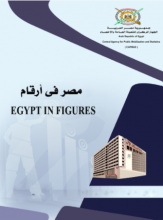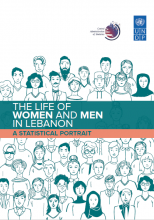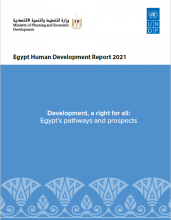Health
The Arab region is estimated to be home to 444.8 million inhabitants, representing 5.6 percent of the World’s population.[1] Arab countries have made significant strides on the health front. Almost all countries have made progress improving health and preventing deaths. Life expectancy at birth has increased from 64.35 years in 1990 to 71.8 years in 2018. Over the past two decades, neonatal mortality rate has declined from 25.2 to 16.7 per 1,000 livebirths and under-five mortality rate has declined from 60.1 to 34.7 per 1,000 livebirths.[2] Communicable diseases, nutritional deficiencies, neonatal disorders and maternal disorders have also declined.[3] Vaccination coverage for DTP, measles and hepatitis B infection have exceeded 86%.[2]
Despite this progress, people in Arab countries live 1-6 years less than in other countries worldwide.[4] Non-communicable diseases remain the major health threats.[2][4] Road traffic accidents, as well as mental and substance use disorders are on rise.[2] Adolescent child birth, unmet need for family planning, smoking and obesity persist.[3][4]Weak health systems and low expenditure on health ranging from less than US$100 per capita in Mauritania, Comoros, Sudan, and Djibouti to over US$ 1,000 in Saudi Arabia, Kuwait, Qatar, and United Arab Emirates. The fact that have generated greater inequality between and within countries, with the poor, uneducated, rural residents and women being most vulnerable moving the discourse from health inequalities to health inequities.[4][5][6]
Furthermore, the decades of regional advances in health were hampered by uprisings and conflicts. In Libya, Syria, and Yemen, these gains have been reversed making the countries very vulnerable to the outbreak of COVID–19. For example in Syria, men have lost close to 8 years in life expectancy and women were subject to abuse and sexual harassment.[7] The Syrian crisis has deeply impacted the health delivery system, draining the health workforce across the country, with 16 percent of all health facilities completely destroyed and 42 percent partially damaged.[8] By mid-2019, 13.2 million Syrians needed health assistance, with females making up 72 percent of them.[9]
In Yemen, only half the healthcare facilities are currently fully functional,[10] and half of the population – two-thirds of the population in rural areas— lacked access to basic healthcare services even prior to the conflict. The country has been suffering from mass outbreaks of communicable diseases and is fighting the worst cholera outbreak recorded in history, where cholera remained widespread in 90 percent of the districts in 2019, with over 1.3 million suspected cases and more than 2,600 related deaths since the April 2017 outbreak.[11] In Libya, only 6 percent of health care facilities provide all essential services, with more than 22 percent of health care facilities are not operational.[12]
Arab countries are facing the COVID-19 pandemic threat. The first case was reported in United Arab Emirates in January 2020.[13] Till February 23, 2021, 4,121,829 COVID-19 positive cases were reported, representing 3.7 percent of the global reported cases.[13] The total COVID-19 reported deaths during the same period was 71,046, representing 2.8 percent of the global reported deaths.[13] The official national figures could be correct up to the level of the screened individuals but do not reflect the real size of the COVID-19 pandemic in the Arab region which is expected to be much more than the reported cases.
The COVID-19 pandemic has stressed the need for three key measures. First, the Arab region should strengthen the production, sharing and use of data and look to health and health equity as the most sensitive indicators for achieving human development. Second, appreciate that building adaptive, responsive and resilient health systems capable of providing full range of healthcare is the route to keep people safe and the economy strong. Third, renew political commitment, with government profound policy integration to provide social protection, secure food and ensure economic development for saving the health and wealth of nations.
This overview has been drafted by the ADP team based on most available data as of February 2021.
________________________________________
Sources:
[1] Population Division of the Department of Economic and Social Affairs of the United Nations Secretariat. 2019. World Population Prospects. [ONLINE] Available at: https://population.un.org/wpp/Download/Standard/Population/ [Accessed 24 February 2021].
[2] The World Bank, World Development Indicators. 2019. [ONLINE] Available at:
https://databank.worldbank.org/source/world-development-indicators [Accessed 24 February 2021].
[3] Global Health Data Exchange. 2020. Institute for Health Metrics and Evaluation (IHME). [ONLINE] Available at: http://ghdx.healthdata.org/gbd-results-tool [Accessed 24 February 2021].
[4] World Health Organization. 2020. World health statistics 2020: monitoring health for the SDGs, sustainable development goals. [ONLINE]: Available at:
https://apps.who.int/iris/bitstream/handle/10665/332070/9789240005105-eng.pdf?ua=1 [Accessed 24 February 2021].
[5] Mansour-Ille, D. 2014. “A Region Without ‘Spring:’ A Tenacious Tale of Poverty, Inequality and Precarity.”International Social Science Journal 65: 221–232. [Accessed 24 February 2021].
[6] Rashad H, Shawky S, Khadr Z, Afifi M, Sahbani S. Reproductive health equity in the Arab region: Fairness and social success. Regional report; The Social Research Center/The American University in Cairo, the United Nations Population Fund /Arab States Regional Office; 2019. [ONLINE] Available at: https://documents.aucegypt.edu/Docs/src/Reproductive-Health-%20Equity-in-the-Arab-Region [Accessed 24 February 2021].
[7] United Nations Development Programme (UNDP). 2019. Arab Human Development Report Research Paper Leaving No One Behind Towards Inclusive Citizenship in Arab Countries, UNDP Regional Bureau for the Arab States (RBAS). [ONLINE] Available at:
https://www.arabstates.undp.org/content/rbas/en/home/library/huma_development/arab-human-development-report-research-paper.html [Accessed 24 February 2021].
[8] The World Bank. July 2017. The Toll of War: The Economic and Social Consequences of the Conflict in Syria. [ONLINE] Available at: https://www.worldbank.org/en/country/syria/publication/the-toll-of-war-the-economic-and-social-consequences-of-the-conflict-in-syria [Accessed 24 February 2021].
[9] United Nations Office for Coordination of Humanitarian Affairs. 2019. 2019 Humanitarian Response Plan (HRP), Syrian Arab Republic. [ONLINE] Available at:
https://reliefweb.int/sites/reliefweb.int/files/resources/2019_Syr_HNO_Full.pdf [Accessed 24 February 2021].
[10] United Nations Office for the Coordination of Humanitarian Affairs. 2020. Global Humanitarian Overview 2020. [ONLINE] Available at: https://reliefweb.int/sites/reliefweb.int/files/resources/GHO-2020_v9.1.pdf [Accessed 24 February 2021].
[11] United Nations Development Programme. 2019. Assessing the Impact of War on Development in Yemen. [ONLINE] Available at:
https://www.undp.org/content/dam/yemen/General/Docs/ImpactOfWarOnDevelopmentInYemen.pdf
[Accessed 24 February 2021].
[12] United Nations Office for the Coordination of Humanitarian Affairs (UNOCHA). 2020. Humanitarian Response Plan: Libya. [ONLINE] Available at:
https://reliefweb.int/sites/reliefweb.int/files/resources/libya_hrp_2020_english_full_v1.pdf [Accessed 24 February 2021].
[13] World Health Organization. 2020. Coronavirus disease 2019 (COVID-19) Situation Report. [ONLINE] Available at: https://www.who.int/emergencies/diseases/novel-coronavirus-2019/situation-reports
[Accessed 24 February 2021].
Data Highlights
-
All countries from WHO's Eastern Mediterranean Region (which contains all Arab countries except Algeria, Mauritania and Comoros) collectively approved the UHC2030 Global Compact.




